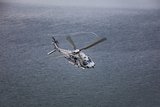Global Positioning Systems Improve Helicopter Safety
Global positioning system technology is being applied to older rotary-wing aircraft to help save lives, a senior helicopter pilot based at Andrews Air Force Base, Md.
Air Force Col. Peter Mapes and other pilots at Andrews will install and test advanced GPS units, designed originally for airplanes, in some of the 316th Wing, 1st Helicopter Squadron’s UH-1N “Huey” helicopters.
“This is game-changing technology because it directly addresses the leading cause of loss of life in this type of aeronautical vehicle,” Mapes said.
The Defense Safety Oversight Council sponsored the test as part of efforts to reduce helicopter mishaps. From 1985 to 2005, 917 non-combat mishaps occurred, resulting in death, injury, damage exceeding $200,000, and the loss of aircraft.
Most helicopter fatalities are caused by impact with terrain – unseen mountains, trees or other obstructions -- known as controlled flight into terrain or CFIT. Because the vehicles are generally moving at high speed during such collisions, more than 90 percent of passengers and crew exposed to these events are injured or killed.
The GPS units installed in the Hueys help prevent- CFITs by displaying maps of potential obstructions at a certain elevation.
“This device has a global terrain database and will warn you of any potential collision," Mapes said. "It also has an obstruction database for North America, Central America and Western Europe that will warn about towers if you're in those areas.”
The new GPS systems, he explained, turn each helicopter into a sort of “mini radar station.” In addition to providing data on obstructions and terrain, it also tracks weather patterns – including lightning strikes, wind flow and rain – and other aircraft in the area.
Unexpectedly bad weather is the second leading non-human factor responsible for Army helicopter mishaps, and the leading non-human factor causing fatalities.
But, by using the new equipment, officials say, a pilot can essentially fly “blind” using the GPS and weather data to make flight plans, observe potential obstructions and even land the aircraft with minimal visibility.
The unit, a GNS-530AWT produced by Garmin, also gives the helicopters radio communication and navigation requirements, making them easy to deploy worldwide.
By Ian Graham - Special to American Forces Press Service
More from Defence Helicopter
-
![Germany to send WS-61 Westland Sea King helicopters to Ukraine]()
Germany to send WS-61 Westland Sea King helicopters to Ukraine
Germany has committed to sending Ukraine six of its 21 retiring WS-61 Westland Sea King multirole, amphibious helicopters.
-
![Boeing secures $271 million to advance modernisation of US Special Operations' MH-47G Chinook]()
Boeing secures $271 million to advance modernisation of US Special Operations' MH-47G Chinook
Boeing has clinched a major contract modification to further its backing of the US Special Operations Command’s MH-47G Chinook aircraft modernisation effort.
-
![Dubai Airshow 2023: South Korean homegrown helicopters make international debut]()
Dubai Airshow 2023: South Korean homegrown helicopters make international debut
Two KAI helicopters, the KUH-1E utility helicopter and the Light Attack Helicopter (LAH), have taken centre stage at the Dubai Airshow 2023.
-
![Italian Navy receives final NH90 helicopter]()
Italian Navy receives final NH90 helicopter
The Italian Navy now boasts a fleet of 56 NH90 helicopters comprising 46 SH-90As and 10 MH-90As.
-
![Argentina seeks AW109 and CH-46 Sea Knight helicopters]()
Argentina seeks AW109 and CH-46 Sea Knight helicopters
The Argentinian Air Force (FAA) and the Argentinian Naval Aviation Command (COAN) are looking for options to upgrade their helicopter fleets.
-
![DSEI 2023: Lockheed to produce about 40% of Black Hawks on UK soil if it wins NMH contest]()
DSEI 2023: Lockheed to produce about 40% of Black Hawks on UK soil if it wins NMH contest
Lockheed Martin promises a boost to the British job market and export opportunities, while strengthening ties with Poland and positioning the UK for a future in rotorcraft technology in the event of a New Medium Helicopter competition triumph.


























